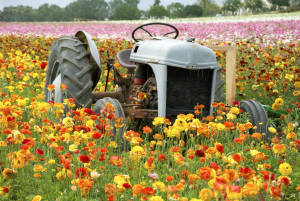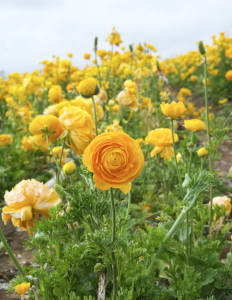
How the Carlsbad Flower Fields Became One of the Most Beautiful Places in America
“Take yourself out of the ordinary,” the Flower Fields at Carlsbad Ranch website instructs. As one of the most beautiful flower farms in America, with nearly 50-acres of what feels like never-ending rows of effervescent ranunculus, the seemingly ordinary quickly fades from memory.
A little girl wearing a matching pink floral dress and ruffled white socks that fold over her tiny sneakers runs through the fields of orange, pink, red, and white flowers with handfuls of dirt, a smile on her face, and a relationship with nature that she’ll likely never forget.
“She’s adorable,” I tell her father. “It’s her first time!” he shares with me, with a smile and a slight eye-roll. “We flew in from New York to be here. I use to work in a building back there,” he gestures over the hill. “It overlooked the flowers… Now we come back to Carlsbad just for this,” he continues.
The ranunculi planting cycle begins in the Fall, as six- to seven- foot tall walls are temporarily positioned to usher million of tiny seeds into their respective rows in the Carlsbad Flower Fields, creating a funnel for them to be pollinated by the wind. This is a requirement for their survival, as ranunculus have no fragrance or nectar to incentivize pollinators. The seeds resemble Quaker Oat flakes, which can often become problematic for the methodical vision the farm strives for– a true synchronicity of variety and color.
In order to give weight and consistency to the seeds, silica sand is mixed in with the seeds before they are sprinkled in the planting rows. A tractor will then form an additional layer of mulch and compost appropriate to their sowing. Approximately four weeks later, the ranunculus seed germinates, but it can take up to six months for lush blossom to take shape.
The Flower Fields in Carlsbad have a reputation that proceeds them: over eight-million ranunculus grow in this distinct region of Southern California annually, blooming in April through May. People come from all over the world to see them. The flowers are watered on a drip-system that the farm has cleverly implemented since the ‘70s. The computerized system acts as a moisture sensor for the soil, enabling farmers to prevent over-watering— water has become an increasingly rare commodity in California these days— and monitors the moisture off-site.
“When the city of Carlsbad installed the reclaimed water line, up Palomar Airport Road, they asked if we would like a sideline to our property,” Fred Clarke, the farm’s General Manager, explained during my visit. “We have access to lots of reclaimed water and the city has said we are somewhat drought-proof because of that. But we are still a working farm with 55-acres of ocean-view property, so monitoring water is always important to us.”
When the ranunculus flowers fade, which happens sequentially beginning at the furthest point north where seeds are first planted, the bulbs’ tuberous root— the bulb of the plant— is harvested by machine. Next, they are air-dried and sorted according to size, before being packaged. The trademarked “Tecolote” Giant Ranunculus bulbs are then distributed to the California Flower Bulb Company, where they are sold at Armstrong Nurseries around the state and throughout nurseries in the U.S., Canada, and Europe under the trademarked name, “Easy to Grow”.
“This is the happiest place on the planet. People from across the world get to immerse themselves in a color experience that is unparalleled…”
“Ranunculus grow wild in the Northeast Mediterranean, but eventually seeds found their way to Europe, the U.S., and to Luther Gage [who is considered the foremost authority when it comes to farming ranunculus],” Clarke explained. Gage began growing the ranunculus next to a small vegetable farm, owned by the Frazee family, who quickly added the flower to their crop.
Of course back then, the flowers were nothing like those you see today— there were five petals. Edwin Frazee, whose father owned the farm, became transfixed with optimizing the ranunculus’ most favorable attributes, which is what led him to propagate the beautiful, spiral-petalled flower we know today.
“He would plant a bunch of seeds, each as individual as you and I are,” Clarke recalls. “The seeds had different qualities and so he picked out plants that had lots of petals, long stems, bright colors and grew them all together, allowing them to pollinate. Then he harvested the seed and planted more of them, repeating that process, which we still do today.
That process began in the ‘40s, but when Frazee reached the point where he knew that the quality of his plants were distinctive— he doubled the size of the flowers with long stems— he called the variety “Tecolote Giant Ranunculus.”
“This area,” Clarke tells us, switching gears, “Used to be countryside [before 150,000 visitors began flocking to the fields each year to see the flowers]. There were owls that burrowed in the ground and the farmers called them Tecolote owls. That’s how he got the name!”
Today, an owl overlooks the expansive ranunculus fields in Carlsbad, serving as the farm’s mascot. The farm will continue to perfect the ranunculi until they become disease-resistant and have longer stems. “After 19 years of working with the Ecke family, who were responsible for 80 percent of the poinsettias sold in the U.S.– before the flower become a potted plant– I wasn’t sure I wanted to do this,” Clarke notes as the sun starts to set.
“But now in my tenth year of managing the farm, I’ve become the nicest guy. This is the happiest place on the planet, and people from across the world get to immerse themselves in a color experience that is unparalleled.”
Check out more gorgeous views from the flower farm, below.







































